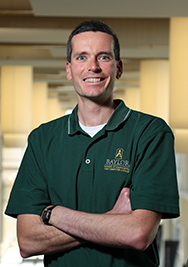
By Caleb Wheeler | Staff Writer
Baylor professors have partnered with 16 other universities and the Department of Defense to enhance the country’s wireless spectrum systems with SMART Hub.
Dr. Charles Baylis, professor of electrical and computer engineering at Baylor, is leading the project.
“If you have a certain frequency available, you could transmit a signal,” Baylis said. “If I’m talking on the phone [with someone], we can transmit at the same time as long as each of us has a frequency that we can access. But … in the United States, there are a lot of applications that need to use this real estate.”
Baylis referred to the space within the radio spectrum as real estate because it’s valuable and limited. Without that real estate, he said the Department of Defense can’t perform necessary tasks for the country’s safety.
“What’s happened now is everything’s done wirelessly, where [someone] probably has three or four devices on [them] at one time,” Baylis said.
SMART Hub is working to find the free space that exists within the radio spectrum.
“Because not everyone needs their spectrum chunk 24/7, you end up with potentially wasted spectrum in a lot of cases,” Dr. Austin Egbert, the director of strategic initiatives at Baylor, said. “The amount of data that is being transmitted wirelessly is growing exponentially, and to be able to support that, we ended up needing to utilize more of the space within the spectrum.”
Baylis said the free space will allow the Department of Defense to run its systems.
“We’re innovating new ways for our Defense Department to use the spectrum,” Baylis said. “For defense, this is really important that we have access to a spectrum, because if I’m going into battle and I can detect missiles coming in from the enemy, I can communicate with my own assets. … And I can jam the enemy’s ability to do this. So if I can do my radar communications and the enemy can’t, I’m going to win.”
Baylis said the method the team found is essentially a timeshare in which not every frequency in the radio spectrum is being used at the same time.
“It turns out through the beauty of electrical engineering that different radios can transmit at the same time if they modulate their signals on a different frequency,” Baylis said. “If we’re going to run out [of frequencies], what we’re suggesting is if we don’t have enough to continue to allocate more spectrum or more real estate or more frequency ranges to do wireless devices, what we need to be able to do is timeshare.”
Egbert said coordination is imperative to the project’s success.
“As things are available, you still need some type of coordination approach to avoid people from kind of stepping on each other’s toes in that sort of environment where you are allowing people to use different parts of the spectrum than they’ve been able to previously,” Egbert said. “There’s already been some work being done with that by the Federal Communications Commission and some other government and industry groups.”
Egbert said he is working to ensure the team follows a vision and evaluates where the project needs to go in order to have the best results.
“The vision right now, and kind of the overall mission statement, is we’re looking to enact a paradigm shift in how the wireless spectrum is used,” Egbert said. “Historically, the way the wireless spectrum is used for different applications is everything gets kind of sectioned up into static bonds that are reserved for different uses.”
Baylis said having students at the forefront of the project is crucial to ensuring its long-term success. He also had high praise for his team of 29 researchers and said working with gracious, self-effacing people makes his job easy.
“We’ve been able to finally secure funding for this, but we really thank all the people who participated along the way,” Baylis said. “I think we’re all excited to begin the actual work of this and do something. Since October, we’re off to the races trying to help the [Department of Defense].”





